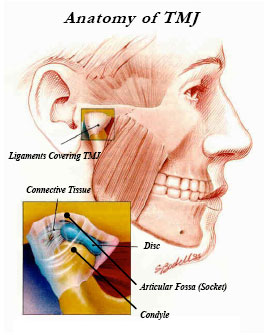Diagnosing TMJ
If you experience orofacial pain that is centered around jaw movements, you could have Temporomandibular joint (TMJ) Syndrome. The TMJ connects your jawbone to your skull, and patients with a temporomandibular disorder (TMD) experience pain in their jaw joint and muscles.
Causes of TMJ Syndrome
While it can be difficult to determine the exact cause of a person’s TMJ Syndrome or TMD, one or more of the below factors are usually at play:
- Genetics
- Conditions such as arthritis
- Previous jaw injury
- Bruxism: the habit of grinding your teeth
The good news is that the pain experienced with TMJ Syndrome is usually temporary and can be treated with non-invasive options. Surgery is usually unnecessary and only recommended as a last resort.

Symptoms of TMJ Syndrome
Below are some of the common symptoms of TMJ Syndrome:
- A clicking sound when you move your jaw
- Pain or tenderness in your jaw or in the temporomandibular joint
- Aching facial pain
- Pain in or around your ear
- Pain when chewing or swallowing
- Joint can get locked, making it hard to open or close your mouth
Diagnosing TMJ Syndrome
If you experience one or more of the above symptoms, to the point that it is affecting your daily life, seek medical attention. You do not have to live with constant pain – an experienced doctor will be able to identify if you have TMJ Syndrome and take the necessary steps. TMJ Syndrome is diagnosed through an observation of the range of movement of your jaw, such as when you open and close your mouth. In addition, your doctor may press on areas around your jaw to identify sites of pain and discomfort. Dental X-rays, CT scans and MRIs are standard procedure if it is suspected you have TMJ Syndrome. These will reveal if the bones involved in your jaw are indeed causing the problem.
Treatment Options for TMJ Syndrome
In some cases, you may find that symptoms disappear by themselves after a while. However, if the pain is persistent, treatment options are available to you:
- Medications: Pain relivers and muscle relaxants can be prescribed to keep the pain under control.
- Physical therapy and devices: Devices such as oral splints can be worn over the teeth to reduce discomfort. Jaw exercises to stretch and strengthen the muscles can also help.
- Cold laser treatment: A painless and non-invasive treatment that makes use of light photons to penetrate the temporomandibular joint, each session of cold laser treatment does not last more than 10 minutes. The purpose is to increase the production of red blood cells, which play an important role in reducing inflammation and enhancing tissue healing.
Why Choose Head Pain Institute® for TMJ Syndrome Treatment?
At Head Pain Institute®, we have an experienced team of head and orofacial pain specialists behind us who come with a combined experience of more than eight decades. On top of that, we hold a Diplomate status from the American Board of Orofacial Pain (ABOP). To date, we have successfully performed more than 12,000 procedures, giving our patients a chance at a new, pain-free existence.
If you have more inquiries about our treatment services for TMJ Syndrome, feel free to call us at (602) 806-6555 or send an email to info@headpaininstitute.com.


